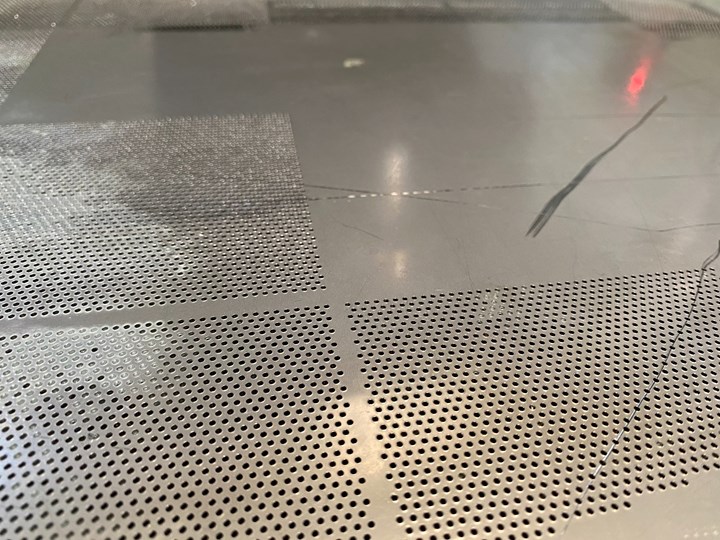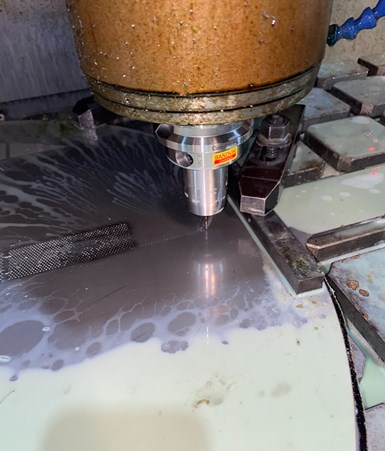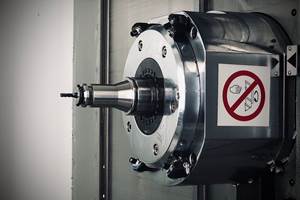Share








.png;maxWidth=45)
DMG MORI - Cincinnati
Featured Content
View MoreThe fight to reduce runout and control heat generation is familiar to every machinist, but it does not affect every process equally. While it is helpful when hogging out a large part, for example, it is vital to achieve tolerance in micro-applications. Steve Lind, VP of Solid Round Tools for Sandvik Coromant, saw this firsthand when working with Aspro Plastic, a Brazilian manufacturer of parts for the plastics industry.
Managing Heat for Microdrills
The application involved making a screen from large, flat stock of 316 stainless steel. The part needed thousands of holes drilled at 1-millimeter in diameter, which combined the challenges of microdrilling with heavy wear on the cutting tool. “At the time, we were machining an inox component with 44,816 holes at 1.0-mm diameter with carbide drills, but we found we needed to improve our cut speed,” says Ricardo Ferreira, product designer and programmer at Aspro.
Aspro Plastics manufactures parts for the plastics industry, including this stainless steel screen. Producing this screen involves drilling 44,816 holes at a diameter of 1 millimeter. Photos courtesy of Sandvik Coromant.
The heat generated by the drilling process, as well as the large number of holes needed, quickly wore out drills. This necessitated multiple tool changes for each part, increasing the time spent on the machine tool. Additionally, the drill’s size made managing heat more difficult, as the machine could not supply through coolant, making external coolant the only option. This made things more challenging, as controlling heat generation was vital to prevent work hardening, Lind says. At only 1 millimeter in diameter, drills easily snap under the additional strain of hardened material.
Aspro turned to the Coromant 1-mm 9×D X2BL microdrill, which nearly halved the machining time per hole and reduced the number of tool changes per part.
Working with Sandvik, the shop opted to revise its process. It eventually settled on using a Coromant 862 family drill, the 1-mm diameter 9×D X2BL microdrill. While this drill was a major improvement, the process improvements were also impactful.
Pecking at the Part
Particularly at the micro level, the right tooling and machine tools are not always enough to succeed. Overcoming the challenges of this application meant pecking: repeatedly pulling the tool back during the drilling cycle to remove chips and dissipate heat.
By “pecking,” Lind says he means engaging the material at an initial depth of approximately 1-3×D and then subsequent “peck” depths of 0.5-1×D until the desired depth is reached. The drill must not leave the hole completely, as fully exiting and reentering the hole risks damaging the tool. Instead, it withdraws just enough for the flood coolant to evacuate chips before reengaging the part. All of this is performed on a Haas VM3.
“There’s not much room for forgiveness when working at this size,” he says. “You will break your drill if you’re not careful.”
In cases where pilot drilling is necessary, it’s important to limit the spindle to 500 RPM at no more than 50% of the programmed feed rate so the tool can locate itself. Once the drill is engaged and 1-2×D into the part, increase to the recommended cutting data. Also, in cases where coolant-through tools are used, it’s imperative to leave the coolant off until the tool is engaged and stabilized in the pilot hole at least 1-2×D deep prior to turning on high-pressure coolant.
To manage heat and evacuate chips, Aspro used a “pecking” toolpath in which the drill repeatedly pulls back during drilling to remove chips.
Even without fully exiting the hole, constantly breaking off contact and reengaging the drill causes a great deal of wear, as it constantly shifts the forces acting on the cutting tool. “Usually, constantly disengaging and reengaging the part is something to be avoided,” Lind explains. “But in this case, it’s the lesser of two evils compared to breaking the drill.”
Increased Productivity
The new drill and revised process led to a 300% productivity increase. “With the old drills, the machining time was eight seconds per hole,” Lind says. “We got that down to 4.7 seconds.” Additionally, the X2BL microdrill is capable of handling many more holes before a tool change while producing a surface finish exceeding 32 RA. “The facility went from handling 6,800 holes per drill to 10,000,” Lind says. “So they’ve reduced the tool changes to four in-process changes per part.
“The Sandvik Coromant microdrill was just the fit for us, because we reduced our cycle time by more than half, with improved cut parameters,” Ferreira concludes. “We also had the confidence that the drill could work overnight, saving us working machine hours. As a result, we saved about 40 hours per component.”
Related Content
How to Troubleshoot Issues With Tool Life
Diagnosing when a tool is failing is important because it sets an expectation and a benchmark for improvements. Finding out why gives us a clue for how to fix it.
Read MoreCustom PCD Tools Extend Shop’s Tool Life Upward of Ten Times
Adopting PCD tooling has extended FT Precision’s tool life from days to months — and the test drill is still going strong.
Read MoreThe Future of High Feed Milling in Modern Manufacturing
Achieve higher metal removal rates and enhanced predictability with ISCAR’s advanced high-feed milling tools — optimized for today’s competitive global market.
Read MoreSelecting a Thread Mill That Matches Your Needs
Threading tools with the flexibility to thread a broad variety of holes provide the agility many shops need to stay competitive. They may be the only solution for many difficult materials.
Read MoreRead Next
Building Out a Foundation for Student Machinists
Autodesk and Haas have teamed up to produce an introductory course for students that covers the basics of CAD, CAM and CNC while providing them with a portfolio part.
Read MoreSetting Up the Building Blocks for a Digital Factory
Woodward Inc. spent over a year developing an API to connect machines to its digital factory. Caron Engineering’s MiConnect has cut most of this process while also granting the shop greater access to machine information.
Read MoreRegistration Now Open for the Precision Machining Technology Show (PMTS) 2025
The precision machining industry’s premier event returns to Cleveland, OH, April 1-3.
Read More




















.png;maxWidth=150)

















.png;maxWidth=300;quality=90)









.png;maxWidth=970;quality=90)